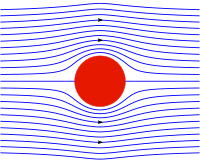
Photo from wikipedia
Abstract A numerical investigation of the combined effects of heating and flow orientation on the forced convective flow of air past a square cylinder is carried out. In order to… Click to show full abstract
Abstract A numerical investigation of the combined effects of heating and flow orientation on the forced convective flow of air past a square cylinder is carried out. In order to account for the effects of large-scale heating like thermal straining of the fluid particles, variations in thermo-physical and transport properties, a fully compressible flow model is utilized. The numerical simulations are carried out using a new flux-based particle velocity upwind scheme (PVU-M+). The computations are carried out in the parametric space of free stream Reynolds number (Re) in the range [60, 140], free stream orientation (α) in the range [0, 45°] and the Over-heat ratio, e = (TW−T∞)/T∞ in the range [0, 1] where TW and T∞ are the uniform cylinder and free stream temperatures. At all parameter combinations the flow is found to be unsteady with vortex-shedding except for (Re = 60, α = 0, e = 0.8, 1.0) and (Re = 60, α = 15, e = 1.0) where vortex-shedding is suppressed resulting in a steady flow. By comparing the data for the global parameters like Strouhal number, mean drag coefficient and mean Nusselt number, with that obtained from a constant property incompressible flow model (Boussinesq type model), a quantification of “large-scale” heating scenario is carried out. Utilizing a novel mathematical procedure, it is shown that the data obtained for the global parameters at different Re and e can be transformed into appropriate scaling parameters that yield an optimal collapse of the data at different (Re, e) combinations for a fixed free-stream orientation.
Journal Title: International Journal of Thermal Sciences
Year Published: 2017
Link to full text (if available)
Share on Social Media: Sign Up to like & get
recommendations!